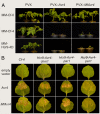Tomato Cf resistance proteins mediate recognition of cognate homologous effectors from fungi pathogenic on dicots and monocots
- PMID: 20368413
- PMCID: PMC2867746
- DOI: 10.1073/pnas.1002910107
Tomato Cf resistance proteins mediate recognition of cognate homologous effectors from fungi pathogenic on dicots and monocots
Abstract
Most fungal effectors characterized so far are species-specific and facilitate virulence on a particular host plant. During infection of its host tomato, Cladosporium fulvum secretes effectors that function as virulence factors in the absence of cognate Cf resistance proteins and induce effector-triggered immunity in their presence. Here we show that homologs of the C. fulvum Avr4 and Ecp2 effectors are present in other pathogenic fungi of the Dothideomycete class, including Mycosphaerella fijiensis, the causal agent of black Sigatoka disease of banana. We demonstrate that the Avr4 homolog of M. fijiensis is a functional ortholog of C. fulvum Avr4 that protects fungal cell walls against hydrolysis by plant chitinases through binding to chitin and, despite the low overall sequence homology, triggers a Cf-4-mediated hypersensitive response (HR) in tomato. Furthermore, three homologs of C. fulvum Ecp2 are found in M. fijiensis, one of which induces different levels of necrosis or HR in tomato lines that lack or contain a putative cognate Cf-Ecp2 protein, respectively. In contrast to Avr4, which acts as a defensive virulence factor, M. fijiensis Ecp2 likely promotes virulence by interacting with a putative host target causing host cell necrosis, whereas Cf-Ecp2 could possibly guard the virulence target of Ecp2 and trigger a Cf-Ecp2-mediated HR. Overall our data suggest that Avr4 and Ecp2 represent core effectors that are collectively recognized by single cognate Cf-proteins. Transfer of these Cf genes to plant species that are attacked by fungi containing these cognate core effectors provides unique ways for breeding disease-resistant crops.
Conflict of interest statement
The authors declare no conflict of interest.
Figures



Similar articles
-
Cladosporium fulvum Avr4 protects fungal cell walls against hydrolysis by plant chitinases accumulating during infection.Mol Plant Microbe Interact. 2006 Dec;19(12):1420-30. doi: 10.1094/MPMI-19-1420. Mol Plant Microbe Interact. 2006. PMID: 17153926
-
The chitin-binding Cladosporium fulvum effector protein Avr4 is a virulence factor.Mol Plant Microbe Interact. 2007 Sep;20(9):1092-101. doi: 10.1094/MPMI-20-9-1092. Mol Plant Microbe Interact. 2007. PMID: 17849712
-
A conserved proline residue in Dothideomycete Avr4 effector proteins is required to trigger a Cf-4-dependent hypersensitive response.Mol Plant Pathol. 2016 Jan;17(1):84-95. doi: 10.1111/mpp.12265. Epub 2015 May 7. Mol Plant Pathol. 2016. PMID: 25845605 Free PMC article.
-
Molecular communication between host plant and the fungal tomato pathogen Cladosporium fulvum.Antonie Van Leeuwenhoek. 1994;65(3):257-62. doi: 10.1007/BF00871954. Antonie Van Leeuwenhoek. 1994. PMID: 7847893 Review.
-
Molecular and biochemical basis of the interaction between tomato and its fungal pathogen Cladosporium fulvum.Antonie Van Leeuwenhoek. 1997 Feb;71(1-2):137-41. doi: 10.1023/a:1000102509556. Antonie Van Leeuwenhoek. 1997. PMID: 9049025 Review.
Cited by
-
A diverse member of the fungal Avr4 effector family interacts with de-esterified pectin in plant cell walls to disrupt their integrity.Sci Adv. 2021 May 7;7(19):eabe0809. doi: 10.1126/sciadv.abe0809. Print 2021 May. Sci Adv. 2021. PMID: 33962956 Free PMC article.
-
A secreted LysM effector protects fungal hyphae through chitin-dependent homodimer polymerization.PLoS Pathog. 2020 Jun 23;16(6):e1008652. doi: 10.1371/journal.ppat.1008652. eCollection 2020 Jun. PLoS Pathog. 2020. PMID: 32574207 Free PMC article.
-
Transcriptional profile of oil palm pathogen, Ganoderma boninense, reveals activation of lignin degradation machinery and possible evasion of host immune response.BMC Genomics. 2021 May 5;22(1):326. doi: 10.1186/s12864-021-07644-9. BMC Genomics. 2021. PMID: 33952202 Free PMC article.
-
Combating a Global Threat to a Clonal Crop: Banana Black Sigatoka Pathogen Pseudocercospora fijiensis (Synonym Mycosphaerella fijiensis) Genomes Reveal Clues for Disease Control.PLoS Genet. 2016 Aug 11;12(8):e1005876. doi: 10.1371/journal.pgen.1005876. eCollection 2016 Aug. PLoS Genet. 2016. PMID: 27512984 Free PMC article.
-
Chitin and chitin-related compounds in plant-fungal interactions.Mycology. 2018 May 15;9(3):189-201. doi: 10.1080/21501203.2018.1473299. eCollection 2018. Mycology. 2018. PMID: 30181925 Free PMC article. Review.
References
-
- Thomma BPHJ, Van Esse HP, Crous PW, De Wit PJGM. Cladosporium fulvum (syn. Passalora fulva), a highly specialized plant pathogen as a model for functional studies on plant pathogenic Mycosphaerellaceae. Mol Plant Pathol. 2005;6:379–393. - PubMed
-
- Stergiopoulos I, De Wit PGM. Fungal effector proteins. Annu Rev Phytopathol. 2009;47:233–263. - PubMed
-
- Wulff BBH, Chakrabarti A, Jones DA. Recognitional specificity and evolution in the tomato-Cladosporium fulvum pathosystem. Mol Plant Microbe Interact. 2009;22:1191–1202. - PubMed
-
- van den Burg HA, et al. Cladosporium fulvum Avr4 protects fungal cell walls against hydrolysis by plant chitinases accumulating during infection. Mol Plant Microbe Interact. 2006;19:1420–1430. - PubMed
-
- van Esse HP, et al. The chitin-binding Cladosporium fulvum effector protein Avr4 is a virulence factor. Mol Plant Microbe Interact. 2007;20:1092–1101. - PubMed
Publication types
MeSH terms
Substances
Associated data
- Actions
- Actions
- Actions
- Actions
LinkOut - more resources
Full Text Sources
Other Literature Sources

